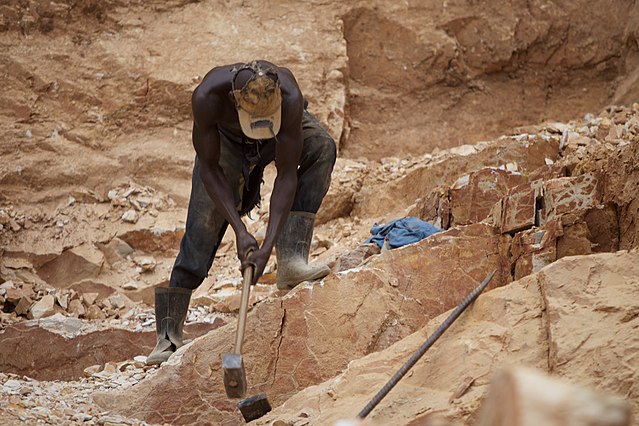BERBÉRATI, Central African Republic — The midday heat settles heavily over the ravine, thick with the smell of damp earth. Barefoot men in tattered shirts lower battered plastic buckets into shafts no wider than a coffin. Nearby, a woman crouches at the river’s edge, swilling a basin of muddy water in slow circles, coaxing flecks of gold to the surface while her baby dozes against her back.
There are no conveyor belts here, no steel cranes or thundering drills. This is mining stripped to its most rudimentary form—spades, rope, and bare hands. Beneath the dust and scrub lies one of the world’s richest seams of gold and diamonds, a geological bounty that, in another nation, might underwrite schools, hospitals, and paved roads. In the Central African Republic (CAR), it has become something else entirely: a fragile promise in a lawless market.
The Paradox of Plenty
The country’s subsoil is rich not only in gold and diamonds, but in rare earth elements critical to the global clean energy economy. Yet, according to the Extractive Industries Transparency Initiative, more than four-fifths of production takes place outside the law—smuggled through informal networks, unrecorded in official ledgers, and untaxed by the state.
“The resources are real,” said Adrienne K. Thompson, a regional analyst with the Natural Resource Governance Institute. “But here, extraction enriches warlords, foreign companies, and corrupt intermediaries far more than it benefits the public.”
Since the overthrow of President François Bozizé in 2013, control of diamond-rich territories has shifted repeatedly among armed groups, undermining government oversight. The Kimberley Process, the global framework designed to halt the trade in “conflict diamonds,” suspended CAR in 2013, later allowing limited exports under tight monitoring. The restrictions remain unevenly enforced.
Foreign Hands, Hidden Ledgers
In recent years, Russian paramilitary units—most linked to the now-fragmented Wagner network—have become a visible presence in the sector. Operating ostensibly as security providers, these groups have secured mining rights in areas beyond state control. A United Nations Panel of Experts reported that Russian-affiliated firms have received preferential licenses and exclusive trading privileges in opaque deals rarely subjected to public scrutiny.
“There is virtually no oversight,” said a Western diplomat based in Bangui, who spoke on condition of anonymity. “Material leaves the country, profits vanish offshore, and there is no transparency about the sums involved.”
Critics warn that this model risks entrenching conflict dynamics. The International Crisis Group has described such foreign-backed ventures as “a new form of extraction without accountability,” fueling local resentment and bypassing public institutions.
A Regulatory Mirage
Efforts to formalize the sector have struggled. A draft mining code intended to strengthen revenue collection and improve transparency has stalled in parliament for more than two years. Transparency International ranks CAR 153rd of 180 in its 2024 Corruption Perceptions Index. Local enforcement is often compromised by officials with direct stakes in smuggling networks.
In mining hubs such as Bria and Bambari, the consequences are stark: children sifting gravel in contaminated water, riverbanks stripped of vegetation, and miners working without protective equipment. “We risk our lives every day,” said Jonas, 24, from Ndassima. “But there’s no other work. No one from the government comes here.”
Small Steps, Uncertain Future
Some interventions have shown modest promise. In Berbérati, a World Bank–supported program is piloting blockchain technology to trace gold exports, aiming to curb illicit trade. Early results suggest the model can improve transparency, though its reach remains limited.
“There is a pathway toward ethical mining,” said Miriam Toko, who heads a civil society group monitoring resource governance. “But without political will and real institutional capacity, it will stay a patchwork of pilot projects.”
Global demand for rare minerals—vital for electric vehicles and renewable energy systems—continues to rise. With the Central African Republic holding reserves still largely untapped, the pressure to exploit them is intensifying. The central question is no longer about geological abundance, but about whether governance can catch up before the resource boom deepens the fractures it promises to mend.
Sources:
- Extractive Industries Transparency Initiative (EITI), Central African Republic Progress Report 2023
- United Nations Panel of Experts on the Central African Republic, Final Report, 2024
- International Crisis Group, In Central African Republic, Diamonds Are Forever a Source of Conflict, 2023
- Transparency International, Corruption Perceptions Index 2024


